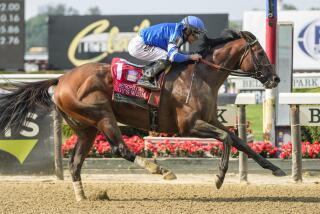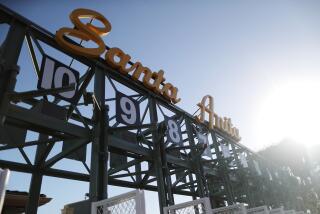On Location: Chief trainer Bobby Lovgren rides high in ‘War Horse’
Horses have long played lead roles in cinema, from the classic movie “National Velvet” to 2010’s “Secretariat,”a drama based on the Triple Crown-winning thoroughbred.
But rarely have they taken center stage as much as they do in “War Horse,”Steven Spielberg’s Oscar-nominated epic about an English farm boy’s lasting relationship with a horse that is sold to the cavalry during World War I.
For chief horse trainer Bobby Lovgren, it was one of the toughest jobs to date. Lovgren has trained horses for movies that included “Seabiscuit,” “Cowboys & Aliens” and “The Legend of Zorro.”
The locally based 46-year-old trainer, however, says nothing compared to the scale of work on “War Horse,” the DreamWorks Pictures movie that has been nominated for six Academy Awards, including best picture. The film, which cost about $70 million to make, was adapted from Michael Morpurgo’s 1982 children’s novel that inspired successful stage productions in London and on Broadway.
Although the acclaimed play used life-sized puppets for horses, the film used more than 150 live horses. Lovgren’s task was to oversee their training. He recruited a team of seven trainers from Australia, Spain and the U.S. as well as groomers, handlers, transporters — even an equine hair and makeup unit.
“What made ‘War Horse’ so special was that it was a combination of everything I’d done before with horses all put into one movie,” Lovgren said in an interview from New Mexico, where he is working on the Disney film “The Lone Ranger,” starring Johnny Depp. “It’s the biggest horse movie I’ve ever done.”
Lovgren is among a select group of animal handlers, trainers and wranglers in the entertainment industry, many of whom live in the northern L.A. County community of Acton, where he owns a small horse ranch.
Teamsters Local 399 has 130 union members who are animal trainers, handlers and wranglers, down from as many as 500 in the 1970s. That reflects the decline in the western movie and television genre and the widespread use of computer effects, which has lessened the demand for live animals in films, said Steve Dayan, a business agent for Local 399.
Nonetheless, animal trainers like Lovgren remain essential and often unheralded behind-the-scene players in Hollywood.
“There are only a handful of guys left like Bobby,” Dayan said. “What they do is a very special art and skill that is a huge part of our history.”
Lovgren came to Hollywood via South Africa, where his parents owned one of the largest riding and jumping stables in the country. He moved to Los Angeles in 1989, learning the ropes from renowned horse trainers Corky Randall and his father, Glenn Randall Sr., who worked on such movies as”Ben-Hur”and “The Black Stallion.”
Lovgren went on to work as a trainer in dozens of movies, including “The Mask of Zorro,” “Running Free” and the 2005 comedy “Racing Stripes,” in which he trained zebras as well as horses.
On “War Horse,” which has grossed $77 million domestically since its Christmas Day release, Lovgren spent 21/2 months training actors to ride and feel comfortable with the horses before filming began in various English locales, including South Devon.
Lovgren and his team had to discern how each of the horses responded to smoke, gunfire and other distractions and assess their individual skills, such as jumping, chasing or pulling. Trainers used body language, hand signals and repetitive exercises to train the horses to perform certain tasks.
Fourteen horses were used to play the title character of Joey, each depicting different stages of his life. One of them was Lovgren’s own horse Finder, whom he purchased after training him in “Seabiscuit.” Lovgren said Finder has a special ability to convey his feelings and connect with audiences. “He’s quite a ham in front of the camera,” Lovgren said.
He collaborated closely with Barbara Carr, a representative of the American Humane Assn., which monitors the welfare of animals used in films.
“I found him to be a wonderful horse trainer,” said Carr, adding that no horses were injured during filming. “He seemed to have a real feeling for the horses.”
Although most of the scenes involved living horses, Spielberg used an animatronic horse for parts of a graphic battle scene in which Joey gets trapped in barbed wire. In the film’s production notes, Spielberg said of Lovgren: “Bobby and his team literally performed miracles with the horses in this film.”







